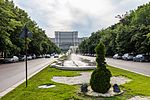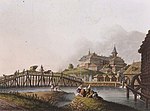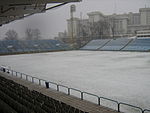People's Salvation Cathedral

The People's Salvation Cathedral (Romanian: Catedrala Mântuirii Neamului), also known as the National Cathedral (Romanian: Catedrala Națională), is an Orthodox cathedral under construction in Bucharest to serve as the patriarchal cathedral of the Romanian Orthodox Church. It is located in central Bucharest on Spirea's Hill (Arsenal Square), facing the same courtyard as the Palace of Parliament which is the heaviest building in the world, the cathedral having a tenth of its weight and about 24% of its volume. Situated behind the Palace of Parliament, this will make it 50 metres taller than the Palace, and will help to make the cathedral an iconic landmark in the city. The People's Salvation Cathedral is 86.2 metres (283 ft) above sea level, and at 135 metres (443 ft) height (ground-cross), holds a dominant position in Bucharest's cityscape, being visible from all approaches to the city.It is the tallest and largest Eastern Orthodox church building by volume, and area, in the world. The People's Salvation Cathedral will have the largest collection of church mosaics in the world (interior decoration) when it is completed, having about 25,000 square meters, including the mosaic of the altar is about 3,000 square meters. The mosaic of the National Cathedral contains glass made in Venice and Florence, as well as Carrara stone. Also the People's Salvation Cathedral has the world's largest Orthodox iconostasis (23.8 meters length and 17.1 meters height) and the world's largest free-swinging church bell.The cathedral is dedicated to the Ascension of Christ, which in Romania is celebrated as the Heroes' Day, and to Saint Andrew the Apostle, protector of Romania. The cathedral was consecrated on 25 November 2018 by the Ecumenical Patriarch of Constantinople Bartholomew I, Patriarch Daniel of Romania and Metropolitan Chrysostomos (gr) of Patras from the Greek Orthodox Church. On the same day as the consecration, the very first church service of the cathedral took place and was led by both Patriarch Bartholomew and Patriarch Daniel. The first patronal feast of the People's Salvation Cathedral was celebrated on 30 November, on the day of Saint Andrew the First Called, and the Liturgy was officiated by Patriarch Theophilos III of Jerusalem and Patriarch Daniel of Romania. The first Te Deum of the cathedral was celebrated on 1 December 2018.
Excerpt from the Wikipedia article People's Salvation Cathedral (License: CC BY-SA 3.0, Authors, Images).People's Salvation Cathedral
Calea 13 Septembrie, Bucharest Centrul Civic
Geographical coordinates (GPS) Address External links Nearby Places Show on map
Geographical coordinates (GPS)
| Latitude | Longitude |
|---|---|
| N 44.425905555556 ° | E 26.082325 ° |
Address
Catedrala Mântuirii Neamului Românesc
Calea 13 Septembrie
050713 Bucharest, Centrul Civic
Romania
Open on Google Maps







